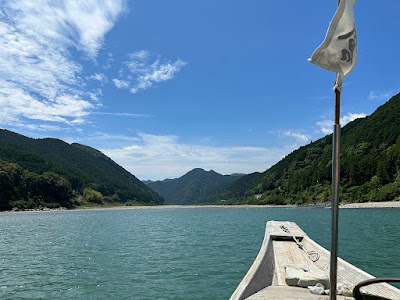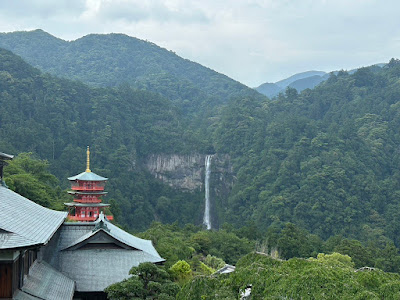Based on the model itinerary on the Kumano Kodo official website, my trip was supposed to last until Day 4, with a visit to Nachi Falls and its surrounding area on that final day. However, due to some schedule changes with my friend, I needed to return to Osaka by 6 pm on the last day. So, after much thought, I decided to squeeze the Day 4 itinerary into the afternoon of Day 3. As it turned out, the route I took could actually be completed in three days. That meant I could leave for Osaka via an early train from Kii-Katsuura on Day 4.
Let’s continue with Day 3. After breakfast, I boarded a bus heading to Shingu and got off at the Michi-no-Eki Kumanogawa bus stop, which is exactly the departure point for the traditional boat ride to Shingu. If river cruising isn’t your thing, you can simply stay on the bus until it reaches Shingu. Along the river, there are a few waterfalls. About halfway through the ride, we made a brief stop at a riverside spot with a white rock believed to be the remains of a defeated demon’s spine. Legend has it that if you touch the rock, you'll gain power (though it's unclear what kind of power). The boat ride then continued until we reached Shingu town. From the landing site, Kumano Hayatama Taisha is just a short walk away. This is one of the Three Grand Shrines of Kumano.
 |
| The boat tour office. Also serving as the departure point. |
 |
| Walking toward the boat. |
 |
| "Demon's spine" rock formation |
 |
| Cruising along the calm river |
 |
| Safely arrived at Shingu shore |
 |
| Kumano Hayatama Taisha |
A bit further south, about 600 meters away, there’s another shrine on a hill that can be reached by climbing a set of stone steps. After exploring Kamikura-jinja, I caught a local bus to Kii-Katsuura. Thankfully, the nearest bus stop is just a short walk from the shrine—thanks to Google Maps for helping me find it. I arrived in Katsuura before 2 pm.
 |
| The steps to Kamikura-jinja |
 |
| Kamikura-jinja shrine |
 |
| Shingu town view from Kamikura-jinja |
After dropping off my backpack at my lodging, I returned to the main bus terminal and boarded a bus to the Nachisan area, arriving around 3 p.m. Of course, the main site—one that needs no introduction—is Kumano Nachi Taisha. Next to it is Seiganto-ji, and just a hundred meters away is the iconic Nachi Waterfall. This would be the final site for stamp collection along Route 3 of the Nakahechi pilgrimage trail. After spending some time there, I took the 5 pm bus back to Katsuura town. That marked the end of Day 3.
 |
| Kumano Nachi Taisha shrine |
 |
| Nachi waterfall |
 |
| Hirou-jinja; Nachi waterfall |
 |
| Nachi waterfall |
 |
| Spring water that can give you longevity |
 |
| All stamps collected for the route |
(Photos were taken with iPhone 14)















Comments